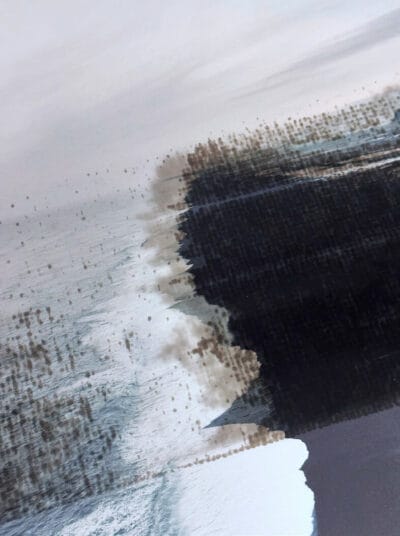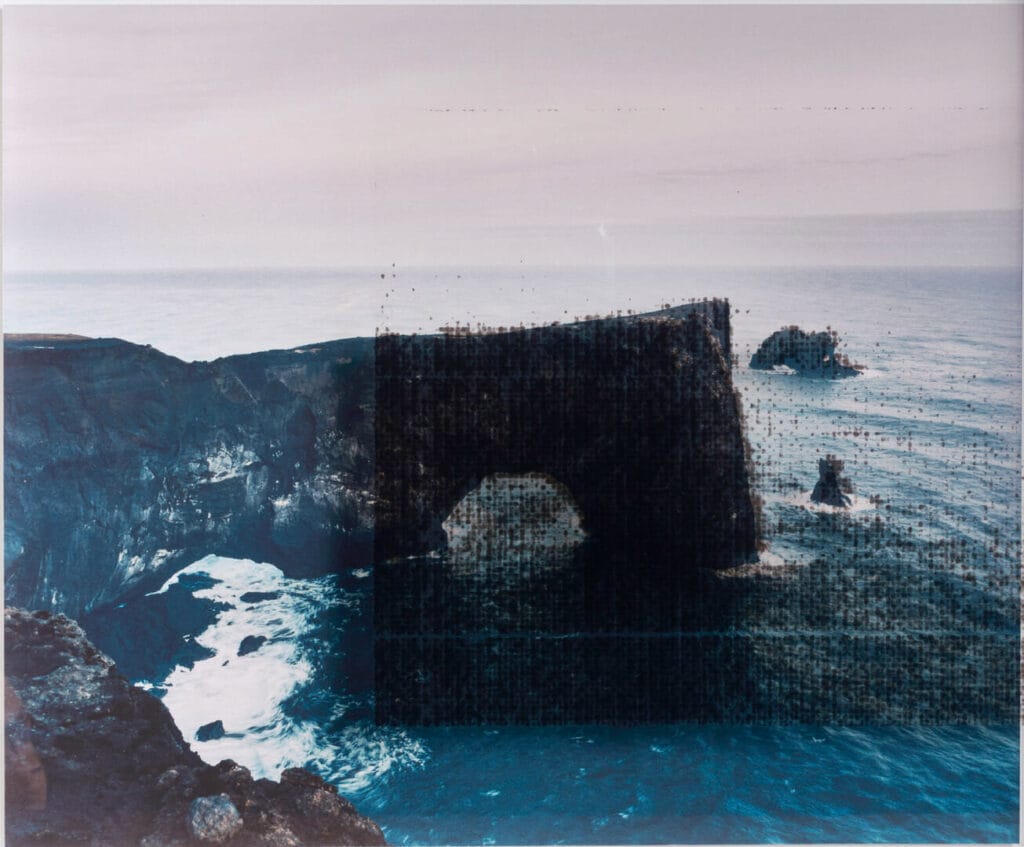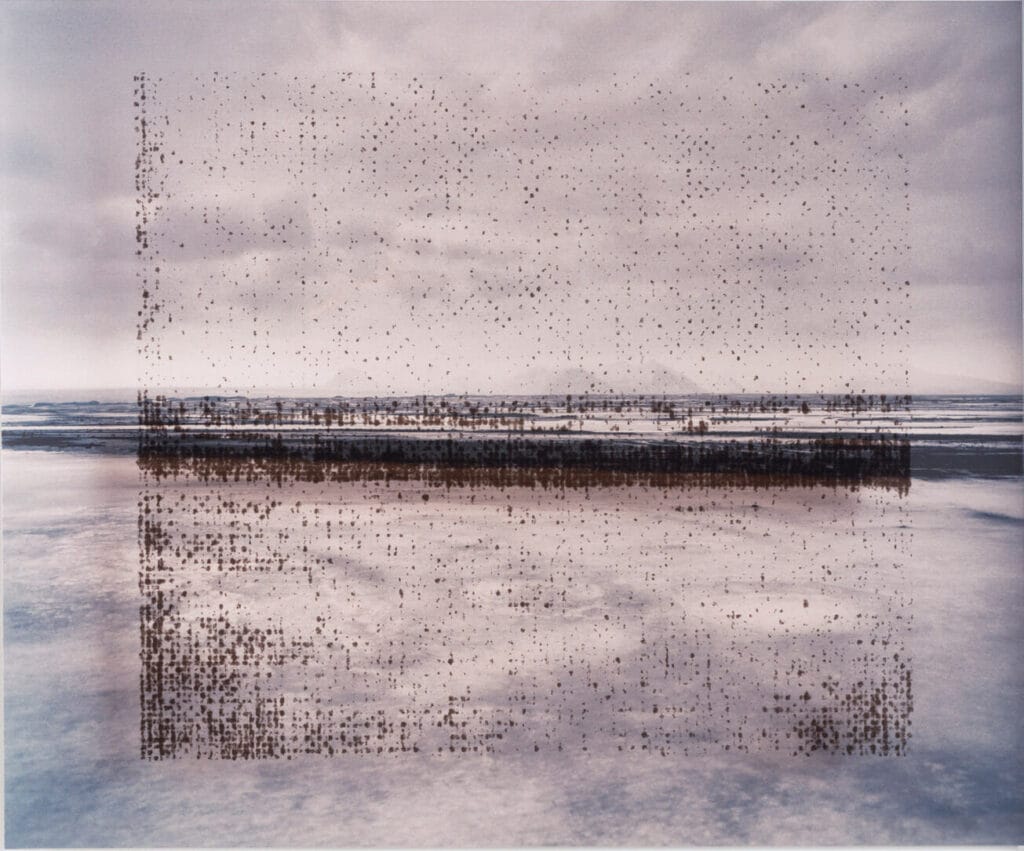The gallery is exhibiting the work of French photographer Vincent Bousserez for the first time.
His photographs are hybrid images, or diptychs as he calls them, in which pigment prints and carbon prints on glass coexist.
In this way, the artist creates two interpretations of the same landscape, which he merges to create a single image, as if he were showing us the making of the landscape in action.
Vincent Bousserez’s photographs are more than just points of view on nature; they are part of a reflection on the status of the image and its reproducibility.

©Vincent Bousserez, courtesy Galerie Esther Woerdehoff
Landscape photography serves as a widespread means of conveying the escalating ecological threat. However, Vincent Bousserez’s approach stands out due to his remarkable ability to unify the subject of the photograph with the photograph itself, creating a cohesive artistic entity. By utilizing the charcoal print on glass technique, an ancient photographic process, he effectively transforms the framed landscape into a haunting mirror image, emphasizing the connection between the image and its tangible form.
Through his Altered series, Vincent Bousserez raises the question of landscape as an invention of our gaze, a place invested with images that have already been assimilated.
Artist statement
As an artist-photographer with a passion for adventure and nature, I travel the remote regions of our planet in search of sublime places to immortalise. My aim is to follow in the long tradition of depicting the landscape as a source of beauty and a reflection of our humanity.
With my new personal series ALTERED, I illustrate in a figurative and formal way our distancing, even our disconnection from our planet, and the way in which the digitisation of our gaze affects the way we see and experience the natural world. Digital capture, particularly via our mobile phones, has overwhelmed us and very often, rather than living fully in the Present, we feel new, irrepressible needs: to create images via a tide of digital captures and to share them.
All this echoes my concerns about the threats to our environment, a subject I’ve tackled in several personal series in recent years.
The pixelation of our world disconnects us from it and gives us a false sense of control over Nature, whereas the pristine landscapes I photograph are ultimately intrinsic proof of our insignificance in geological time.
In January 2022, I began the project ALTERED.

Pigment print and carbon print on glass
Edition of 3, 53 x 43 cm
©Vincent Bousserez, courtesy Galerie Esther Woerdehoff
In order to represent our digitalized view of our world, I imagined the creation of dypticals superimposing two images of the same landscape: a perfect silver image and a crude, damaged, altered digital image.
I went to Iceland to shoot, a country that I love so much, magnetic, photogenic, and a perfect representative of those natural geographies that are photographed over and over again because they are subject to ever-increasing tourism.
Using, playing with and twisting the photographic medium: photography between document and contemporary art.
In the early days of photography, before it was technically possible to fix and stabilise images, photographic experiments were carried out on leather, glass, tin coated with bitumen of Judea, or using guaiac resin.
The image, fleeting and evanescent, flew, vanished, playing tricks on those who tried to tame it and hold it captive.

Pigment print and carbon print on glass
Edition of 3, 53 x 43 cm
©Vincent Bousserez, courtesy Galerie Esther Woerdehoff
In my series ALTERED, I felt I was reviving this empirical tradition: it was important for me to find an old-fashioned silver-based method of fixing this second image directly onto the glass of the frame. And I wanted to make these prints myself, so that all the elements made by my own hands would become a work of art.
Charcoal printing on glass: an ode to craftsmanship & a highly symbolic material.
My choice fell on the technique of charcoal printing on glass.
Dating back to the 19th century, this photographic process is a laborious technique that is difficult to master. It requires a great deal of time and work to produce a single image.
It contrasts with the speed and ease with which images can be produced using smartphones, digital cameras, the retouching software that I have mastered and, increasingly frighteningly, artificial intelligence.
The use of this traditional technique to represent the beauty of nature is symbolic of the importance of preserving our natural heritage in the face of the ecological crisis.
Coal is a fossil fuel whose combustion is one of the main causes of global warming. By choosing to superimpose these two types of print, I wanted to create a work that represents the beauty of nature while reminding us of the need to reduce our carbon footprint.
For several months, I experimented with and refined this method of carbon printing on glass. I was confronted with numerous constraints, failures and blockages, but little by little I put in place a technique that allowed me to obtain the result I had hoped for a year earlier when I had imagined this project.
I also love the idea of bringing these images to life using a very old process, even though they are digital in origin.
It’s April 2023 and my first pieces are finally finished.
– Vincent Bousserez
Galerie Esther Woerdehoff
36 Rue Falguière, 75015 Paris, France





